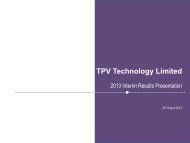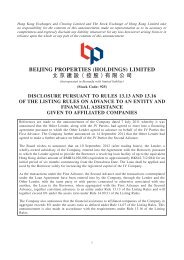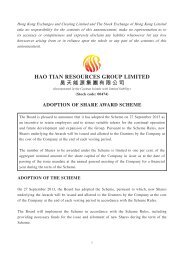Interim Report 2012 - TodayIR.com
Interim Report 2012 - TodayIR.com
Interim Report 2012 - TodayIR.com
- No tags were found...
Create successful ePaper yourself
Turn your PDF publications into a flip-book with our unique Google optimized e-Paper software.
Notes to Financial Statements30 June <strong>2012</strong>2.4 SUMMARY OF SIGNIFICANT ACCOUNTING POLICIES (Continued)Business <strong>com</strong>binations and goodwill (Continued)Impairment is determined by assessing the recoverable amount of the cash-generating unit (group of cash-generating units) to whichthe goodwill relates. Where the recoverable amount of the cash-generating unit (group of cash-generating units) is less than thecarrying amount, an impairment loss is recognised. An impairment loss recognised for goodwill is not reversed in a subsequent period.Where goodwill forms part of a cash-generating unit (group of cash-generating units) and part of the operation within that unitis disposed of, the goodwill associated with the operation disposed of is included in the carrying amount of the operation whendetermining the gain or loss on disposal of the operation. Goodwill disposed of in this circumstance is measured based on the relativevalues of the operation disposed of and the portion of the cash-generating unit retained.Impairment of non-financial assetsWhere an indication of impairment exists, or when annual impairment testing for an asset is required (other than inventories, deferredtax assets, financial assets, goodwill and non-current assets), the asset’s recoverable amount is estimated. An asset’s recoverableamount is the higher of the asset’s or cash-generating unit’s value in use and its fair value less costs to sell, and is determined for anindividual asset, unless the asset does not generate cash inflows that are largely independent of those from other assets or groups ofassets, in which case the recoverable amount is determined for the cash-generating unit to which the asset belongs.An impairment loss is recognised only if the carrying amount of an asset exceeds its recoverable amount. In assessing value in use,the estimated future cash flows are discounted to their present value using a pre-tax discount rate that reflects current marketassessments of the time value of money and the risks specific to the asset. An impairment loss is charged to the in<strong>com</strong>e statements inthe period in which it arises in those expense categories consistent with the function of the impaired asset.An assessment is made at the end of each reporting period as to whether there is any indication that previously recognisedimpairment losses may no longer exist or may have decreased. If such an indication exists, the recoverable amount is estimated. Apreviously recognised impairment loss of an asset other than goodwill is reversed only if there has been a change in the estimatesused to determine the recoverable amount of that asset, but not to an amount higher than the carrying amount that would havebeen determined (net of any depreciation/amortisation) had no impairment loss been recognised for the asset in prior years. Areversal of such an impairment loss is credited to the in<strong>com</strong>e statement in the period in which it arises.Related partiesA party is considered to be related to the Group if:(a)the party is a person or a close member of that person’s family and that person:(i)(ii)(iii)has control or joint control over the Group;has significant influence over the Group; oris a member of the key management personnel of the Group or of a parent of the Group.orINTERIM REPORT <strong>2012</strong> 27
















